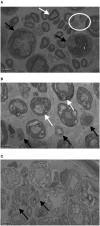Selective Fiber Degeneration in the Peripheral Nerve of a Patient With Severe Complex Regional Pain Syndrome
- PMID: 29670505
- PMCID: PMC5893835
- DOI: 10.3389/fnins.2018.00207
Selective Fiber Degeneration in the Peripheral Nerve of a Patient With Severe Complex Regional Pain Syndrome
Abstract
Aims: Complex regional pain syndrome (CRPS) is characterized by chronic debilitating pain disproportional to the inciting event and accompanied by motor, sensory, and autonomic disturbances. The pathophysiology of CRPS remains elusive. An exceptional case of severe CRPS leading to forearm amputation provided the opportunity to examine nerve histopathological features of the peripheral nerves. Methods: A 35-year-old female developed CRPS secondary to low voltage electrical injury. The CRPS was refractory to medical therapy and led to functional loss of the forelimb, repeated cutaneous wound infections leading to hospitalization. Specifically, the patient had exhausted a targeted conservative pain management programme prior to forearm amputation. Radial, median, and ulnar nerve specimens were obtained from the amputated limb and analyzed by light and transmission electron microscopy (TEM). Results: All samples showed features of selective myelinated nerve fiber degeneration (47-58% of fibers) on electron microscopy. Degenerating myelinated fibers were significantly larger than healthy fibers (p < 0.05), and corresponded to the larger Aα fibers (motor/proprioception) whilst smaller Aδ (pain/temperature) fibers were spared. Groups of small unmyelinated C fibers (Remak bundles) also showed evidence of degeneration in all samples. Conclusions: We are the first to show large fiber degeneration in CRPS using TEM. Degeneration of Aα fibers may lead to an imbalance in nerve signaling, inappropriately triggering the smaller healthy Aδ fibers, which transmit pain and temperature. These findings suggest peripheral nerve degeneration may play a key role in CRPS. Improved knowledge of pathogenesis will help develop more targeted treatments.
Keywords: complex regional pain syndrome (CRPS); nerve histology; peripheral nerve; remak bundle; transmission electron microscopy.
Figures





Comment in
-
Commentary: Selective Fiber Degeneration in the Peripheral Nerve of a Patient With Severe Complex Regional Pain Syndrome.Front Neurosci. 2019 Feb 5;13:19. doi: 10.3389/fnins.2019.00019. eCollection 2019. Front Neurosci. 2019. PMID: 30804734 Free PMC article. No abstract available.
References
Publication types
Grants and funding
LinkOut - more resources
Full Text Sources
Other Literature Sources

